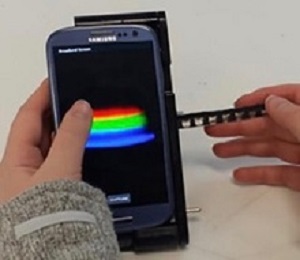 Researchers have developed technology that for $550 enables a smartphone to perform lab-grade medical diagnostic tests on blood, urine and saliva samples as that typically require large, expensive instruments reliably as clinic-based instruments that cost thousands of dollars.
Researchers have developed technology that for $550 enables a smartphone to perform lab-grade medical diagnostic tests on blood, urine and saliva samples as that typically require large, expensive instruments reliably as clinic-based instruments that cost thousands of dollars.
Costing only $550, the spectral transmission-reflectance-intensity (TRI)-Analyser from University of Illinois at Urbana-Champaign bioengineering and electrical & computer sngineering Professor Brian Cunningham's lab attaches to a smartphone and analyses patient blood, urine, or saliva samples as reliably as clinic-based instruments that cost thousands of dollars.
"Our TRI Analyser is like the Swiss Army knife of bio-sensing," said Cunningham, the Donald Biggar Willett professor of engineering and director of the Micro + Nanotechnology Lab at Illinois. "It's capable of performing the three most common types of tests in medical diagnostics, so in practice, thousands of already-developed tests could be adapted to it."
In a recently published paper, Cunningham's team used the TRI Analyser to perform two commercially available assays – a test to detect a biomarker associated with pre-term birth in pregnant women and the PKU test for newborns to indirectly detect an enzyme essential for normal growth and development. Their tests results were comparable to those acquired with clinic-grade spectrometer instrumentation.
"The TRI Analyser is more of a portable laboratory than a specialised device," said Kenny Long, an MD/PhD student and lead author of the research study.
Among the many diagnostic tests that can be adapted to their point-of-care smartphone format, Long said, is an enzyme-linked immunosorbent assay (ELISA), which detects and measures a wide variety of proteins and antibodies in blood and is commonly used for a wide range of health diagnostics tests. The system is capable of detecting the output of any test that uses a liquid that changes color, or a liquid that generates light output (such as from fluorescent dyes).
The TRI Analyser operates by converting the smartphone camera into a high-performance spectrometer. Specifically, the analyser illuminates a sample fluid with the phone's internal white LED flash or with an inexpensive external green laser diode. The light from the sample is collected in an optical fibre and guided through a diffraction grating into the phone's rear-facing internal camera. These optical components are all arranged within a 3D-printed plastic cradle.
The TRI Analyser can simultaneously measure multiple samples by using a microfluidic cartridge that slides through an opening in the back of the cradle. This ability to analyse multiple samples quickly and reliably makes the Analyser suitable for patients who lack convenient access to a clinic or hospital with diagnostic test facilities or for patients with urgent health situations requiring rapid results.
"Our Analyser can scan many tests in a sequence by swiping the cartridge past the readout head, in a similar manner to the way magnetic strip credit cards are swiped," said Long.
In addition to its applications in health diagnostics, Cunningham said the TRI Analyser can also be applied to point-of use applications that include animal health, environmental monitoring, drug testing, manufacturing quality control, and food safety. The patented technology is available for license.
Abstract
We demonstrate a smartphone-integrated handheld detection instrument capable of utilizing the internal rear-facing camera as a high-resolution spectrometer for measuring the colorimetric absorption spectrum, fluorescence emission spectrum, and resonant reflection spectrum from a microfluidic cartridge inserted into the measurement light path. Under user selection, the instrument gathers light from either the white “flash” LED of the smartphone or an integrated green laser diode to direct illumination into a liquid test sample or onto a photonic crystal biosensor. Light emerging from each type of assay is gathered via optical fiber and passed through a diffraction grating placed directly over the smartphone camera to generate spectra from the assay when an image is collected. Each sensing modality is associated with a unique configuration of a microfluidic “stick” containing a linear array of liquid chambers that are swiped through the instrument while the smartphone captures video and the software automatically selects spectra representative of each compartment. The system is demonstrated for representative assays in the field of point-of-care (POC) maternal and infant health: an ELISA assay for the fetal fibronectin protein used as an indicator for pre-term birth and a fluorescent assay for phenylalanine as an indicator for phenylketonuria. In each case, the TRI-analyzer is capable of achieving limits of detection that are comparable to those obtained for the same assay measured with a conventional laboratory microplate reader, demonstrating the flexibility of the system to serve as a platform for rapid, simple translation of existing commercially available biosensing assays to a POC setting.
Authors
Kenneth D Long, Elizabeth V Woodburn, Huy M Le, Utsav K Shah, Steven S Lumetta, Brian T Cunningham
[link url="http://bioengineering.illinois.edu/news/article/23435"]University of Illinois College of Engineering material[/link]
[link url="http://pubs.rsc.org/en/Content/ArticleLanding/2017/LC/C7LC00633K#!divAbstract"]Lab on a Chip abstract[/link]
